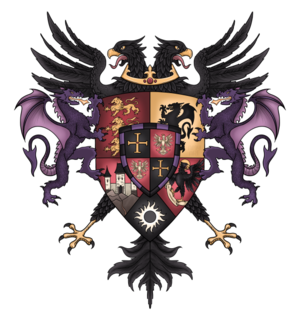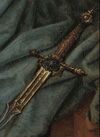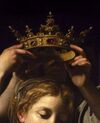House of Stassion
|
| House of Stassion is a Heartlander royal house which descended from the mainline Novellen lineage. In the present times it has broken the Novellen name to be nothing more than a relic of ancestry. It now rules over the Marchlands as its sovereign protector and prince after its expulsion from the United Kingdom of Aaun. |
Contents
History of Stassion ✠
The House of Stassion is derived from the main line of the House Novellen, which was first formed when the House of Sarkozic came into possession of the Pertinaxi Inheritance through the marriage of Joseph II, Holy Orenian Emperor, son of the Lord Protector Adrian Sarkozic, and Anne I, Holy Orenian Empress, daughter and heiress of Peter III, Holy Orenian Emperor. Consequently, the House can trace its lineage to both the Horenic and Karovic bloodlines. The name of ‘Stassion’ itself is derived from Stassion Castle, the Royal palace located in the city of Vienne from which the household originates. Much of the House’s history stems from its progenitor, the House of Novellen, which is best characterized by the tumultuous events that preceded its rise to power. Prior to the Petrine Era and the rise of the House of Novellen, the Holy Orenian Empire was ruled by the House of Horen, which faced internal strife resulting from multiple competing claimants descended from various different branches. Moreover, the House of Horen faced several external problems as well, having numerous powerful, discontent vassals spread across the Empire. All of these issues which plagued the House of Horen would culminate in the War of Two Emperors, ultimately leading to the downfall of House Horen and a resulting dark age within the Empire, referred to in the modern era as the Time of Troubles. In this context, many historians view the House of Novellen, specifically during the Petrine Era, as reactionary to its Horenic predecessors. Where the House of Horen was divided by rival claimants, the Patriarchs of House Novellen took steps to consolidate their bloodline, marrying the descendants of Imperial dynasts back into the mainline and therefore ensuring that the House retained the sole claim to the Imperial throne. Moreover, the Novellen Emperors during the Petrine Era took various measures to centralize the territories of the Empire under the Imperial crown, eroding away much of the power of previously held vassals in favor of a centralized Imperial administration. Much of these values and traditions formed by the House of Novellen in response to the failings of their predecessors have indirectly been imparted on the House of Stassion. Though consanguineous marriages are largely considered to be an archaic practice in the modern era, the lingering effects of such are still present in the House of Stassion today, with much of the House of Stassion’s dynasts bearing hair of a reddish-brown hue resulting from continuous cousin marriages. Furthermore, the governance and militia of Stassion strongly resembles that of its Imperial and Royal predecessors, a testament to its heritage. Much of the Novellen heraldic elements have also been passed down to the House of Stassion as well.
Hailing from the longest reigning Orenian Dynasty, the progenitors of the House of Stassion would rule over the Heartlands for over a century. Much of these crown heads came from the Petrine Era, which spans over the life and death of four Imperial monarchs. The Petrine Era would come to an abrupt end following the sudden deposition of Philip II, Holy Orenian Emperor in favor of his grandson, Philip Amadeus. The newly crowned Philip III, Holy Orenian Emperor, alongside his wife, Anastasia I, Holy Orenian Empress, would usher in a period of change and reform within the Empire, giving rise to the Aster Empire. The unexpected deaths of both monarchs, however, would lead to a civil-war within the Empire instigated by their sons, Prince Peter Augustus and Prince Frederick Charles, both vying for the Orenian throne. Frederick Charles would ultimately prevail over his brother, dissolving the Empire in favor of an Orenian Kingdom. The newly crowned Frederick I, King of Oren would reign for fifteen years before being murdered by rebels during the Acre Rebellion. The crown would then pass to his nine year old son, Frederick Aurelian. Regally known as Frederick II, King of Oren, the young king would only reign for only a year before his regency council surrendered to the rebels. This would mark the end of the Novellen Dynasty’s rule over the Heartlands, and of the Novellen dynasty itself, with the name having fallen into utter ruin. Though the House of Novellen had come to an end, the House of Stassion, descending from Richard Leonus, was born. Having spent years in exile, the second born son of Frederick II would re-emerge within the then Archduchy of the Petra under the tutelage of his aunt, the Countess of Mardon. The prince would set about building his own household, and would be granted a County within the Petra. Prince Richard would go on to expand his territories, and the lands of Stassion would later be transferred to the United Kingdom of Aaun, where it would be promoted to the rank of Margraviate. Presently, the House rules over the Western Marches of the United Kingdom of Aaun, with the head of house bearing the titles of Prince of Providentia and Margrave of Stassion. While much of the history of the House of Stassion is intertwined with that of the House of Novellen, it is important to not mistake one for the other. Though the House of Stassion descends from the mainline House of Novellen and shares its histories, the House of Stassion has since broken away from the Novellen line in favor of existing as its own separate entity.
Culture of Stassion ✠
Marked by the strife and turmoil which have forged their identity, the Marcherfolk are a proud and militant people, harboring a deep distrust of outsiders though fiercely loyal to their own. Rejecting frivolity or finery, the people of the March choose to embrace the simplicity of humble living and enduring strength, for in a world often twisted by war, such constancy prevails. Similarly, the foundations of the society of the Marchlands was built upon ideals such honor and common goodness. Each person, be they the lowly peasant or the esteemed lord, has a solemn duty to contribute to the shared welfare of the state, for all have a role to play within the March.
Stassion Relics ✠
| Conquest |
The Boomsteel Arming Sword, an awe-inspiring masterpiece that seamlessly marries lethal precision with captivating design, stands as a testament to the pinnacle of craftsmanship. Its formidable straight-edged blade extends gracefully to approximately 31 inches, commanding attention with each inch. The crossguard, a meticulous creation perfectly perpendicular to the blade, showcases quillons fashioned as menacing spikes, strategically poised to aid in delivering devastating murder-strikes with chilling efficacy. Complementing this deadly elegance is the pommel, a multifaceted representation of the sun, not merely a visual embellishment but a densely constructed element designed for potent bashing capabilities, adding a layer of practicality to its aesthetic allure. Forged from Medium Density Boomsteel, the sword's surface exhibits a mesmerizing tapestry of veins and streaks, providing a visual symphony that hints at the material's inherent strength and durability. What truly sets this blade apart is its extraordinary ability to produce flames, a manifestation of the volatile nature of Boomsteel. This dazzling display of fiery prowess serves as more than mere spectacle; it becomes a functional element, a means to expel excess heat and energy with a mesmerizing dance of flames that lasts for up to [6] emotes, heightening the allure and danger of the weapon. The resplendent golden luster that adorns the sword is not a mere embellishment but a result of a meticulous quenching process in St. Tobias' Boone, a revered technique that not only enhances its visual appeal but contributes significantly to its overall resilience. As a final stroke of craftsmanship, an inscribed litany adorns the length of the blade, a profound declaration echoing through the ages: "The hand of GOD is the greatest weapon to bear, and His word is the paramount strategy." This inscription transcends the sword's physicality, serving as a constant reminder of its divine inspiration and the sacred purpose it might bear in the hands of its wielder, elevating it beyond the realm of a mere weapon to become a symbol of faith and power that resonates with the echoes of history.
| Aster Circlet |
The Circlet of Phillip III, a resplendent artifact that earned unparalleled favor from its wearer to the extent that it purportedly surpassed the allure of a conventional crown, stands as an enduring testament to opulence and enigma. Crafted with meticulous artistry, the circlet boasts a thick and weighty band of gold, upon which the singular and commanding word 'Aster' is intricately engraved, a profound declaration of significance etched into the very heart of its precious metal surface. Yet, the interior of the band holds an additional layer of mystery, as faint markings, reminiscent of letters, grace its innermost recesses. These inscriptions, though incomplete and indecipherable, exude an air of mystique that only serves to deepen the layers of intrigue surrounding this Imperial relic. The golden band finds itself enveloped by a delicate embrace of a thinner piece of velvet cloth, its seamless winding around the circlet devoid of any discernible signs of having been tied or altered. This seamless integration unveils a unique origin, suggesting that the circlet was not merely adorned with the cloth but rather forged through it, creating an inseparable union that silently testifies to the unparalleled craftsmanship responsible for this exceptional artifact. The questions that arise concerning the arcane methods employed in the creation of such a distinctive piece only add to the enigma shrouding the circlet's origins. Furthermore, the Circlet of Philip III reveals an extraordinary level of durability, resisting easy breakage and prompting speculation about potential reinforcement on the inside of the golden band. This internal fortification introduces yet another layer to the mysteries enshrouding the circlet, leaving observers to ponder the meticulously chosen materials and craftsmanship that contribute to its seemingly impervious nature. In the grand tapestry of imperial regalia, the Circlet of Philip III doesn't merely signify authority; it emerges as an enigmatic masterpiece, its golden exterior and velvet embrace concealing secrets and histories that beckon both admiration and curiosity. The rich narrative woven into its very structure invites those who gaze upon it to explore the depths of its past, rendering it not just a symbol of power but an enduring enigma waiting to be unraveled.
Wars ✠
- Aevos Coalition War ⚔ (1946)
Patriarchs of Stassion ✠
| Name | Portrait | Birth Parentage |
Marriage(s) Issue |
Death | Coat of Arms | Title(s) |
|---|---|---|---|---|---|---|
| Richard I Richard Leonus Stasion |
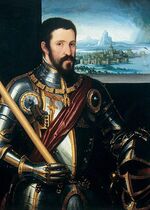
|
1914, County of Mardon
Son of Fredrick II of Oren |
Ottavia of Pompourelia
Aurelia, Richard, Mathilde, Adelheid, Catherine, Cordelia, Baldwin |
Alive | 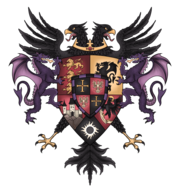
|
Prince of Stassion Duke of the Lowlands, Duke of Vienne, Duke of Lorraine, Duke of Furnestock, Margrave of Rhosmark, Protector of the Marchlands (titular) |
| Richard II Richard Leonus Stasion |
150px | 1939, Stassion
|
Noemie of Summerhall
Cecily |
Alive | 
|
Prince of Stassion Duke of the Lowlands, Duke of Vienne, Duke of Lorraine, Duke of Furnestock, Margrave of the Westermarch, Baron of Renzfeld, Baron of Montfort, Lord of Fredericksburg, Protector of the Marchlands (titular)
|
